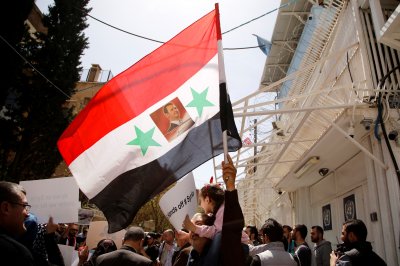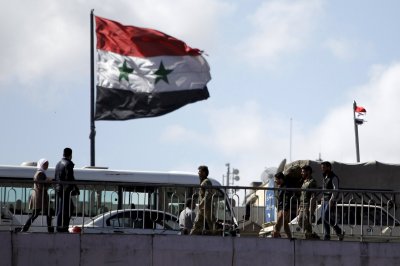Two Years Of Russia's Military Operation in Syria
September 30 marks the second anniversary of the Russian counterterrorism military operation in Syria. Unlike the efforts by the United States and its international coalition, the Russian campaign in Syria is fully legitimate. It was launched at the request of Syrian President Bashar Assad. Sputnik presents a look into the results of the Russian aerial campaign in Syria after two years.
Operation of the Russian Aerospace Forces in figures
30 000
combat sorties
92 000
airstrikes
96 000
terrorist targets destroyed
As of September 2017, 86 percent of the Aerospace Forces' flying personnel gained combat experience.
The Syrian campaign has involved:

Long-range aviation crews
75%
75%
Operational and tactical aviation crews
79%
79%
Military transport aviation
88%
88%
Army aviation crews (helicopters)
89%
89%


87.4 percent of Syria's territory liberated

2,237
residential areas are now part of the cease-fire regime
Terrorist targets destroyed by the Russian Aerospace Forces

25,526
terrorist command and fortified posts

528
oilfields, refineries, fuel pumping stations and fuel transporting convoys
53,707
terrorists
970
terrorist training camps

6,769
weapons and ammo depots
9,328
miscellaneous terrorist targets
International Mine Action Center of the Russian Armed Forces
5,295
hectares of territory cleared of mines
60,384
explosive devices defused
102
Syrian sappers undergoing training
586
Syrian sappers trained
Mine clearance operations
Palmyra
(summer 2016)
(summer 2016)
In the course of a month-a-half-month-long operation over 800 hectares of territory, 23 kilometers of roads and 10 heritage sites were cleared of explosives. Over 2,500 buildings were also cleared of mines. Some 17,500 explosive objects were defused, as well as 400 improvised explosive devices. The Mine Action Center resumed operations after Palmyra was liberated for the second time; 1,514 hectares were cleared of mines and 6,609 explosive devices were found and destroyed.
Aleppo
(December 2016 — February 2017)
(March 8, 2017 — April 20, 2017)
(December 2016 — February 2017)
(March 8, 2017 — April 20, 2017)
A total of 2,956 hectares, 945 kilometers of roads and more than 4,500 buildings (including 90 schools, four day care centers and 25 medical centers) were cleared of explosives. Some 36,000 explosive devices were defused.
Deir ez-Zor
(September 2017 — present)
(September 2017 — present)
The mine clearance operation involved 175 specialists of the Mine Action Center and 42 units using special engineering equipment.
Liberation of Palmyra
In May 2015, armed terrorist groups entered the area of Tadmur where the ruins of the ancient city of Palmyra are located.
Palmyra was seized by militants and liberated two times. While under the control of terrorists, a lot of historic sites were demolished in the city.
As part of the Palmyra operation, the Russian Aerospace Forces performed over 500 combat sorties and carried out over 2,000 airstrikes on Daesh positions in the period between March 7 and March 27, 2016.
Two operations in Palmyra
March 13, 2016
The Syrian Army launched an offensive to retake Palmyra, which was seized by Daesh in May 2015.
March 26
Terrorists were forced to retreat to the north to the outskirts of Palmyra.
March 28
With the assistance of Russian aviation, Russian Special Forces (Spetsnaz) units and Russian military advisers, the Syrian Army liberated Palmyra.

Mid-December 2016
Daesh militants once again took over the ancient city after two days of attacks.
March 1, 2017
The Syrian Army backed by its allied militia forces regained strategic control over Palmyra.
March 2, 2017
The Syrian Army backed by the Russian Aerospace Forces completed the second liberation of Palmyra.
Liberation of Aleppo
Operation Dawn of Victory in November-December 2016 was one of the most important parts of the battle for Aleppo. During the operation, Russian warplanes hit Daesh positions with cruise missiles in northwest Syria.
November 16
The Syrian Army launched an assault on residential areas in northwestern Aleppo.
November 29
The majority of areas in West Aleppo were placed under control of the Syrian military.
December 11
The Syrian Army regained control over 96 percent of Aleppo.
December 22
The city was completely liberated.
After the city was cleared of militants, specialists of the International Mine Action Center of the Russian Armed Forces were engaged in an explosive clearance operation. In order to maintain law and order in Aleppo, units of the Russian Military Police were deployed to the city.
Russian Army Engineers Demine Schoolhouse in Aleppo
Landing operation behind Daesh rear
On August 12, the Syrian Army conducted a unique landing operation, deploying paratroopers behind Daesh positions 20 km from the battlefront. The operation resulted in the liberation of the town of al-Hadar. Russian military advisers were involved in the planning of the paradrop.
Prior to the operation, the Syrian artillery and Russian Ka-52 combat helicopters launched attacks on Daesh positions and equipment in the area.
Prior to the operation, the Syrian artillery and Russian Ka-52 combat helicopters launched attacks on Daesh positions and equipment in the area.

Breach of the Deir ez-Zor blockade

Syrian forces after breaking the Deir ez-Zor blockade
On September 5, 2017, Syrian forces backed by its allied militia units broke the three-year blockade of Deir ez-Zor and forced their way to the positions of the 137th brigade that had been maintaining defense of the besieged city.
"With your fortitude, you have proved your responsibility before the future generations. It will go down in history how you, despite your small number, sacrificed the most valuable for the sake of civilians. Today, you and your friends fought shoulder to shoulder to lift the siege of the city."

Bashar Assad
President of Syria
The success of the Syrian Army was facilitated by a massive Russian missile strike, including Kalibr cruise missiles launched from the Admiral Essen frigate of the Russian Navy.
The missile strike resulted in the destruction of a number of terrorist targets, including fortified positions, a network of underground tunnels, firing positions and ammo depots.
A look at weapons involved in the Russian operation in Syria
Tu-160
The Tu-160 ("White Swan") is a supersonic variable-sweep wing missile-carrying strategic bomber. The aircraft is capable of carrying both nuclear and conventional bombs. It has a combat radius of over 7,000 kilometers and a range of nearly 14,000 kilometers without in-flight refueling. Currently, its modernized version, the Tu-160M2, is being prepared for production.
The Tu-160 ("White Swan") is a supersonic variable-sweep wing missile-carrying strategic bomber. The aircraft is capable of carrying both nuclear and conventional bombs. It has a combat radius of over 7,000 kilometers and a range of nearly 14,000 kilometers without in-flight refueling. Currently, its modernized version, the Tu-160M2, is being prepared for production.
The Tu-160 was developed back in the Soviet era and made its combat debut during the Syrian operation.
The Tu-160 is the largest supersonic aircraft in the history of military aviation and the heaviest combat aircraft in the world, with the largest takeoff weight.
The Tu-160 is the largest supersonic aircraft in the history of military aviation and the heaviest combat aircraft in the world, with the largest takeoff weight.
Russian strategic bombers fire cruise missiles on Daesh in Syria
Admiral Kuznetsov
Currently, the Admiral Kuznetsov heavy aircraft-carrying missile cruiser continues to remain Russia's only aircraft-carrying warship. At the same time, it is one of the most capable ships with the Russian Navy. The Syrian campaign was the first combat operation for the warship.
A group of Russian warships headed by the Admiral Kuznetsov, accompanied by the Pyotr Veliky battle cruiser, the Severomorsk and Vice-Admiral Kulakov anti-submarine destroyers and the Admiral Grigorovich frigate and support vessels, started a counterterrorism operation in Syria on November 8, 2016.
Currently, the Admiral Kuznetsov heavy aircraft-carrying missile cruiser continues to remain Russia's only aircraft-carrying warship. At the same time, it is one of the most capable ships with the Russian Navy. The Syrian campaign was the first combat operation for the warship.
A group of Russian warships headed by the Admiral Kuznetsov, accompanied by the Pyotr Veliky battle cruiser, the Severomorsk and Vice-Admiral Kulakov anti-submarine destroyers and the Admiral Grigorovich frigate and support vessels, started a counterterrorism operation in Syria on November 8, 2016.
Admiral Kuznetsov was carrying over 40 planes and helicopters. On November 15, the Su-33 aircraft carrier-based fighter jet was used in combat for the first time. During its two-month-long deployment to the Mediterranean, the Russian carrier-based aviation conducted 420 sorties, destroying 1,252 terrorist targets in Syria, including with cruise missiles. In February 2017, the aircraft carrier group returned to Severomorsk.
Admiral Kuznetsov in action
Kalibr cruise missiles
The Kalibr was initially designed for Russia's advanced multipurpose nuclear submarines, but later the missiles were also added to the arsenal of surface ships. The Kalibr missile can be launched from both diesel-powered and nuclear subs. The missile has an operational range of nearly 2,500 kilometers.
The Kalibr was initially designed for Russia's advanced multipurpose nuclear submarines, but later the missiles were also added to the arsenal of surface ships. The Kalibr missile can be launched from both diesel-powered and nuclear subs. The missile has an operational range of nearly 2,500 kilometers.
Russian Frigate Strikes Daesh With Kalibr Cruise Missiles
Russian Warships Launch Cruise Missiles on al-Nusra Front Targets in Syria
Ka-52 "Alligator" combat helicopter
The Ka-52 is a modification of the Ka-50 "Black Shark" attack helicopter. The Ka-52 is a new generation combat reconnaissance-and-attack helicopter. It is designed to destroy enemy tanks, armored and non-armored vehicles, and helicopters and personnel day and night and in all-weather conditions.
The Ka-52 is a modification of the Ka-50 "Black Shark" attack helicopter. The Ka-52 is a new generation combat reconnaissance-and-attack helicopter. It is designed to destroy enemy tanks, armored and non-armored vehicles, and helicopters and personnel day and night and in all-weather conditions.
The helicopter can also be used for a range of other purposes, including target reconnaissance missions, fire support of landing troops, patrolling missions and escorting military convoys.
The Ka-52 has been used against terrorists in Syria starting April 2016.
The Ka-52 has been used against terrorists in Syria starting April 2016.
Russian Ka-52 Helicopters Hit Daesh Targets in Syria
Other missions of the Russian Aerospace Forces in Syria
Russian Su-34 Jets Deployed in Iran Strike Daesh in Syria
Russian Bombers Struck Daesh Targets
Airstrikes Of The Russian Aerospace Forces In Syria
Russia Builds A Bridge Across The Euphrates River
